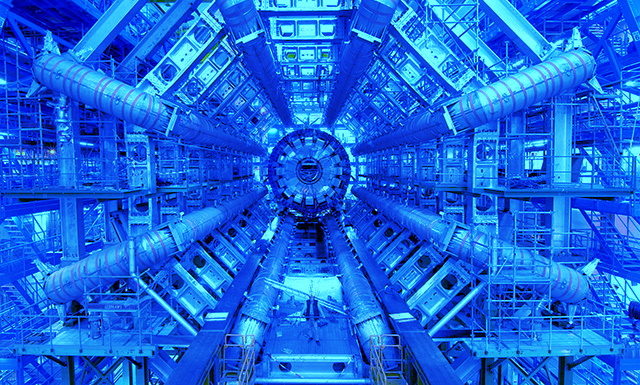
Dimension of scale
Hey Sokrates! How're you doing?
Thanks, fine! Today is the perfect weather for philosophizing again.
What question are you pondering about today?
Well, you know, I was just thinking about dimensions.
Oh I know what you mean. We live in a three dimensional world. So there are three dimensions.
Yes, that's true. But what if there were only two dimensions?
Oh I read a book about it. Wait, what was it called? Oh yes it was "Flatland - A Romance of Many Dimensions (by a square)" by Edwin A. Abbot.
Did you also read it. I especially like the part hwere Edwin describes how it would look like for a flat earther, when a sphere passes through his flat world. At first there would be nothing. When the spere first touches the two dimensional plane he lives in, he'd see (not see?) a point. When the sphere starts to penetrate his plene, he'd see a circle ...
Uh, Sokrates. I am really very sorry, for interupting you. But I think you missed something. Since that flat earther is living within his two dimensional plane, I think he wouldn't see a circle. Instead he would see a line.
Ok I understand what you mean. But this is not quite right. Yes that flat earther would see a line, which is the projection of a two dimensional circle into one dimension. But it is still a circle. If there were multiple bystanders at different viewing angles and they would communicate between each other, then they could become aware of the fact, that the line that each of them sees is acutally a circle.
Oh ok, I was just considering that one viewer. Having multiple point of views of course you are right.
So that thing that flat earther sees would grow in size, until its length equals the diameter of the sphere. Then it would start getting smaller and smaller. Until it finally vanishes, as if it would never have been there.
I can image the flat earther would be quite perplexed by this experience.
Luckily it doesn't happen too often, that a three dimensional sphere passes through a two dimensional plane.
Just imagine, if a four dimensional sphere would passs through our three dimension time all the time. Wouldn't that be anoying? (What did I just say???)
<smiles> Oh yes that would defenitely be something. Just start about thinking what would happen, if you 'touch' this four dimensional spehre? Would there be any resistance our would you just pass through it?
Which color would it have?
Color can be defined as as a class of spectra that give rise to the same color sensation at an individual ...
Uh Sorkates, you are digressing again. We wanted to talk about another dimension!
Oh, sorry, I drifted off again ... I promise to STOP ("STay On toPic") more.
No worries. Ok, now about another dimension.
Oh yes, another dimension. Well actually quite simple: What if self-similarity was another dimension?
Self what?
Self-similarity, when an object is exactly or approximately similar to a part of itself (i.e., the whole has the same shape as one or more of the parts)
But I thought the whole is more than the sum of its part.
Now you are digressing.
Sorry. :-(
Self-similarity is a very well known concept that appears everywhere in nature, for example in flowers. It became well-known, when Benoit Mandelbrot discoverd the beauty of fractals. You can zoom into a Mandelbrot set and re-discover the same structures again and again.
Aaaah, now I remember. You are talking about these mind-expanding zoom-in animations that were created from that simple formula f_c(z) = z^2
Exactly.
But why would that be a dimension?
Well, think about it. Aren't planets circling around a central star, not just the same as electrons circling around a nucleus?
Oh come on! Now you are fantasizing!
Why? Electrons can take multiple levels of discrete energy, ie. circling on specific circular pathes at specific radiuses. This is just the same for plantes. A mass can only circle around a central star at one specific radius, where the gravity of the star is exactly equal to the the centrifugal force that results from its speed of rotation.
But how would that mass change its energy level?
Well, for example by being hit by another electron, uh I mean, a meteor. Either the planet is completely knocked out of its start system, ie. it "radiates". Or the comet is smaller and only hits the planet. Then the plant's mass increases by the mass of the commet. The planet must thein either move to an orbit with larger diameter or increase its rotation speed, to maintain a stable path around the central star. This depends of the angle of the impact.
But Sokrates, we are shooting electrons onto other particles in the greatest machine that humanity has ever built regularly. But in a straight line (from a cicular LHC) How shall we examine the "angle o f impact"?
You know what I always moan about: That's like trying to repair a highly complex computer processor with a hughe soldering iron. That tool just simply isn't capable of grasping the complexity of the testee. Although its the most complex one we've ever build. But that's another story.
So are we lost?
Not at all. We are progressing in the right direction. We are beginning to understand the genuine complex structure of matter itself.
But what about that additional dimension?
Hey my dear friend. It's getting late. Sun has already set a while ago. Let's continue our uplifting discussion tomorrow.
Yes I totally agree. I am also quite tired already.
So have a good night and see you tomorrow!
You too!
All content on Doogie.de is licensed under
Creative Commons BY-NC 4.0
